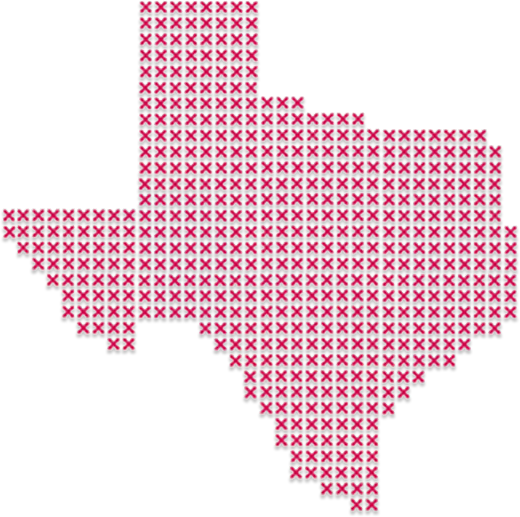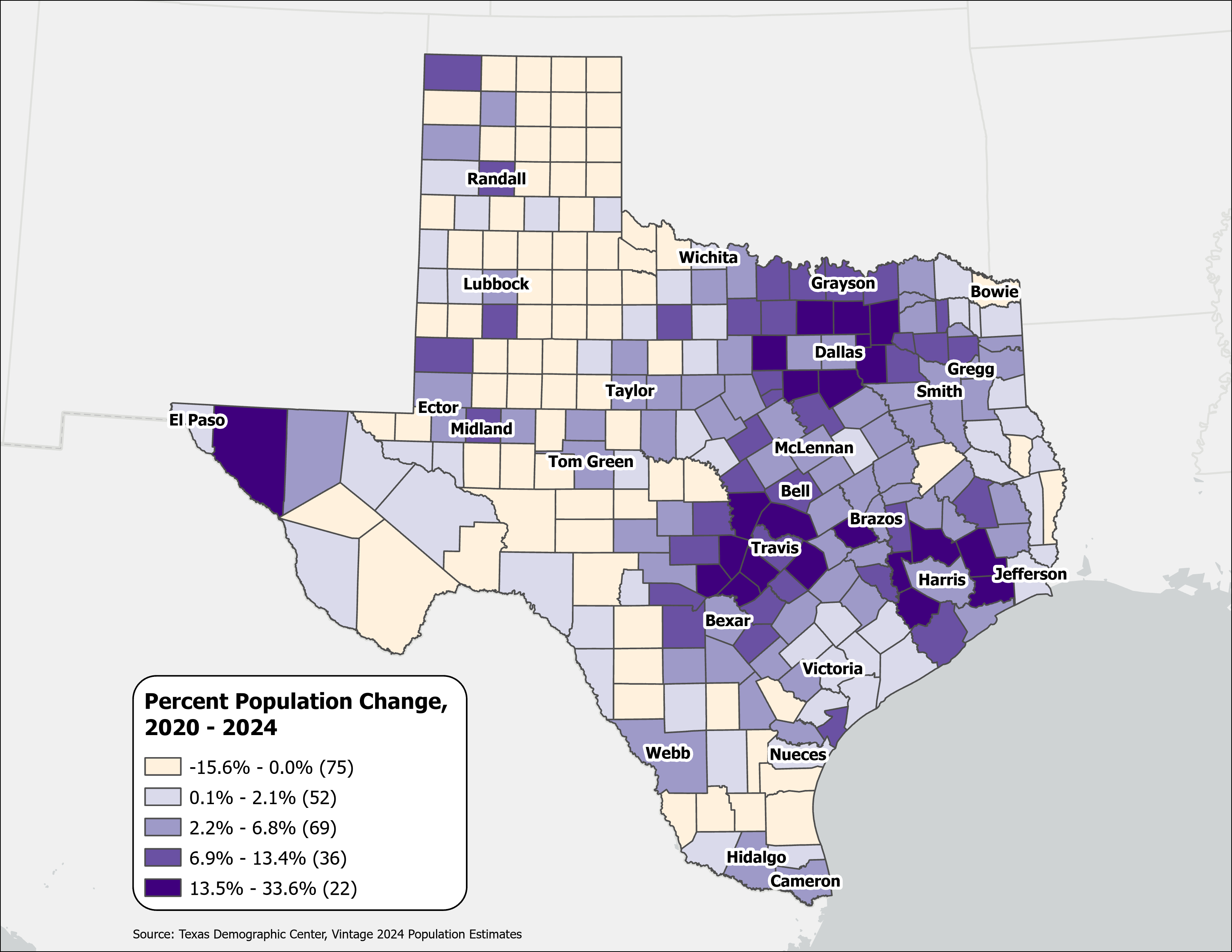Texas Population Estimates Program
The Texas Population Estimates Program produces annual estimates of the total populations of counties and places in the state. Estimates of county populations are also available by age, sex, and race/ethnicity. Finalized population estimates are published on our website in the fall of every year.
To access the 2010-2020 intercensal estimates of population totals for various geographies, visit the U.S. Census Bureau website ( National | Metro | State | County | City and Town ).
Vintage 2024 Population Estimates
Final population estimates for counties and places in Texas, and the county population by age, sex, and race/ethnicity are now available for July 1 of each year from 2021 through 2024, as well as for January 1, 2025.
NEW! In the Vintage 2024 population estimates, we have included revised estimates for the period from July 2021 to July 2023. This adjustment is due to significant changes made by the Census Bureau to the Texas state estimates since 2021, which also affect the TDC county estimates. For more details, please refer to the methodology statement.
If you have downloaded the preliminary estimates, please note that we have made changes to our final estimates based on the feedback and new information we have received since the release of the preliminary estimates. The final estimates may be accessed from the files below.
If you have any questions, please go to our Frequently Asked Questions (FAQ) section for quick answers and helpful information.
View the population estimates in your area
| Name | Census | Estimate | 2020-2024 | 2020-2025 | ||||||
|---|---|---|---|---|---|---|---|---|---|---|
| 2020 April |
2021 July |
2022 July |
2023 July |
2024 July |
2025 January |
Number | Percent | Number | Percent | |
Percent Population Change for Texas counties, 2020-2024
Texas has experienced substantial population growth since 2020, primarily concentrated in major metropolitan statistical areas. In contrast, some counties in West Texas have seen population declines. To illustrate these trends, the Texas Demographic Center created a map showing the percentage change in population for Texas counties from April 2020 to July 2024.
View Map
Access Vinatge 2024 Population Estimates
Suggested Citations
| Data | |
|---|---|
| Total Population by County | |
| Total Population by Place | |
| Total Population By Metropolitan Statistical Area | |
| Total Population By Council of Governments | |
| Age, Sex, and Race/Ethnicity for State and Counties | |
| Methodology | |
|---|---|
| Total Population | |
| Age, Sex, Race/Ethnicity | |
| Data Tool | |
|---|---|
|
Custom Download
Watch our tutorial to learn how to create a custom table by downloading data by year, age, sex, race, ethnicity and geography. |
|
Texas Population Estimates Annual Surveys
The Texas Demographic Center's Texas Population Estimates and Projections Program, overseen by the State Demographer, conducts surveys to create population estimates for the State of Texas in compliance with Chapter 468 of the Texas Government Code. These estimates are crucial for a wide range of users, including state agencies, policymakers, local governments, and private enterprises, to effectively plan and secure the resources and funding meet the needs of Texans. The accuracy and availability of these population estimates depend on the cooperation of the survey respondents.
Information from Texas counties, cities, and educational institutions is collected through five annual surveys from October to February.
- Higher Education Survey - collects enrollment totals and the number of students living on campus from higher education institutions.
- Private School Survey -collects enrollment totals for students in grades 1-8.
- Annexation & Boundary Survey - collects information related to boundary changes that may affect the population from incorporated places.
- New Residential Units Surveys (Incorporated Places/Unincorporated Areas) - collect information from cities and counties concerning new residential housing units in the incorporated places and unincorporated areas.
Frequently Asked Questions - Population Estimates Program
The production timeline for our population estimates spans the entire year. Data collection begins in July of the estimate year by gathering administrative data from state agencies. It closes the following June with the finalization of the TDC survey cycle.
Data enters the processing phase after collection, followed by an internal review period. The production and internal review of the group quarters population, which are facilities that house groups of unrelated individuals, such as prisons, college dormitories, and nursing homes, continues until July. An internal review of county and place estimate totals occurs from July through September.
Following this internal review, these preliminary population estimates are shared with an external review board and local governments, initiating a comment period. During this comment period, reviewers can communicate possible errors or changes they believe should be made to the estimates. After appropriately updating the estimates according to the feedback received during the comment period, the final county and place population estimates are then released in the first week of November.
Our population estimates are based on three types of data: survey data, administrative data, and publicly available data.
Survey Data: Five annual surveys, conducted from October to February, collect information from Texas counties, cities, and educational institutions.
- Higher Education Survey: This survey collects enrollment totals and the number of students living in university-owned housing from higher education institutions.
- Private School Survey: This survey collects student enrollment totals for grades 1-8.
- Annexation & Boundary Survey: This survey collects information related to boundary changes that may affect the population of incorporated places.
- New Residential Units Surveys (Incorporated Places/Unincorporated Areas): This survey collects information from cities and counties concerning new residential housing units in the state’s incorporated places and unincorporated areas.
Administrative Data: Our office collects administrative data from national and state agencies. These data include federal and state prison statistics, vital statistics, voter registration numbers, vehicle registration numbers, public school enrollment data, nursing home population counts, and manufactured home data.
Publicly Available Data: The U.S. Census Bureau produces publicly available data, including the Decennial Censuses, American Community survey, monthly building permit data, and Population Estimates.
We use these data sources to produce our population estimates because they are available across the state and are comparable across years. They are also highly correlated with the population and are commonly used in well-established methods for population estimates.
The Texas Demographic Center and the U.S. Census Bureau provide population estimates for Texas, focusing on county and place totals as of July of each year. Additionally, both programs offer state and county estimates by age, sex, race, and ethnicity, as well as total population estimates for places. However, there are differences in the methodologies and data offered.
| U.S. Census Bureau’s Population Estimates | Texas Demographic Center Population Estimates | |
|---|---|---|
| Data released in each vintage of estimates |
Estimate totals for the State, counties, and incorporated places Estimates by age, sex, race, and ethnicity for the State and counties Estimates for all years since the base year of the Decennial Census Components of change estimates (birth, death, migration) ‘Part’ Place estimates (the breakdown of place estimates by county) Estimates of the unincorporated areas of each county Housing unit estimates |
Estimate totals for the State, counties, and incorporated places Estimates by age, sex, race, and ethnicity for the State and counties Estimates for July 1st of the vintage year and January 1st of the following year with numerical and percent change calculated since the base year of the Decennial Census |
| Release timeline | Released incrementally from December to July | Released in November of every year |
| Race and ethnicity categories |
Not Hispanic and Hispanic Alone or in combination categories for:
|
|
| Age categories | Ages less than 1 year old to 85 years and older | Ages less than 1 year old to 95 years and older |
Differences in the input data and methodology used will lead to slight variations between the TDC population estimates and the Census Bureau’s estimates. Take consistency into consideration when deciding which estimates to use. If you have referenced estimates from the TDC in the past, then continue to do so. Refrain from combining estimates from both sources to avoid inconsistencies in the data across years. Also consider the timing of the estimates’ release and the data offered when deciding which source to use.
The review process for our population estimates begins with an internal review, where TDC staff compares results across the three methods used: the component method II, the housing unit method, and the ratio correlation method. Additionally, we evaluate our estimates against those from other sources, such as the Census Bureau estimates, and we analyze historical trends for consistency. Following the internal review, an external review is conducted. The Texas Demographic Center sends the preliminary estimates to an external estimate review board consisting of state and local governmental units, who may provide new or alternative data or assess the suitability of the estimates in specific areas.
Respond to our Annual Surveys: Local data and knowledge are crucial to the production of accurate population estimates. You can assist us in our mission by consistently responding to our annual surveys on residential units and annexation information for your municipality or county. Help ensure that we have up-to-date contact information so that your government can continue to receive important correspondence from our office.
Participate in the external review process: Make your voice heard by participating in the external review process for our preliminary population estimates, which occurs every October. The external review process allows you to indicate any errors or appropriate changes you believe should be made to the estimates. We ask that you provide additional data to substantiate potential errors and information to suggest alternative estimates. Our population estimates may be revised following this review process.
Contact us: Lastly, do not hesitate to communicate any questions or concerns you may have with our population estimates outside of the external review process. Our office will work with you to address your concerns and provide additional information about our estimates. Send us an email at tdc@utsa.edu



